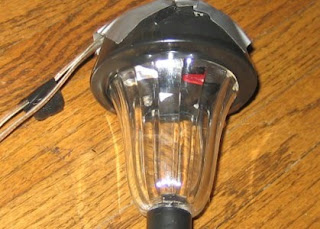 So, you may think that I have too much free time, but the thing is, I like to tinker.
So, you may think that I have too much free time, but the thing is, I like to tinker.If you happen to have one of these cooling fans (which you probably do, if you have as much outdated technology as I do), take it out of the computer case, and remove the plastic around the circuit board (wear goggles, plastic pieces will go flying everywhere). If you have outdated technology that may still be useable, consider donating it to this charity for re-use.
On the circuit board, you will see 3 gobs of solder that are a little bigger than the other gobs. use a knife to cut into the circuit board around these gobs, to prevent the electricity from leaking to other components on the board.
solder a wire to each one. (come to think of it, solder first and then cut. then you don't have to worry about your pathetic messy soldering job messing things up.) Attach 2 led's to each pair combination of wires, and determine which pair gets the most blink. with 3 wires, this will be 3 combinations. (n^2 + n)/2 = 6, but /2 since ba=ab. maybe you use 4 led's and all 3 wires?
Next, get a 2-liter plastic bottle and a glue-gun. Cut out the smooth mid-section of the bottle. Divide the width of this (the circumference of the bottle) by 7 (the number of blades on the fan). Cut the curved plastic into 7 equal rectangular strips. Next, figure the shape of the blade as something similar to what is pictured below. The reason the blade must be thinner at the edge has to do with the pitch angle. The angle of attack from the point of view of the wind must be the same for the whole blade. This varies as a function of (distance from center) * Pi * (rotational interval) There is an interesting video about how to make one out of pvc.

Use the glue gun to adhere the blades to the fan. make sure the straight edge is perpendicular to the tangent of the center circle (i.e. the blades are pointing straight out)
Glue-gun a stick to the back circuit board, and walla! a lawn ornament that is guaranteed to embarrass whoever you live with.




